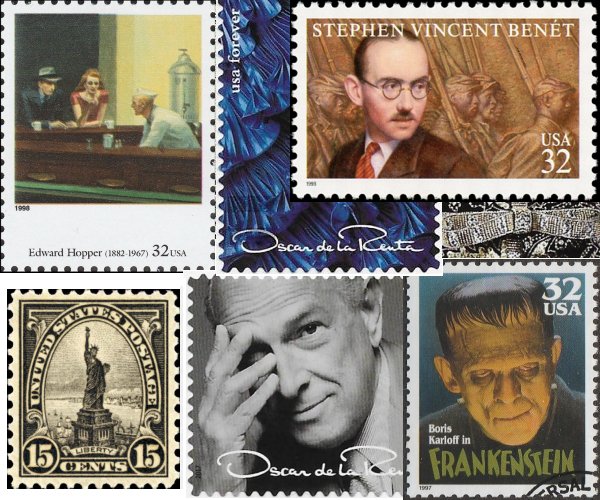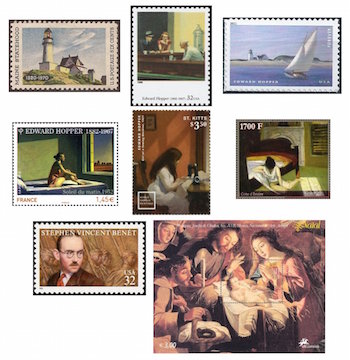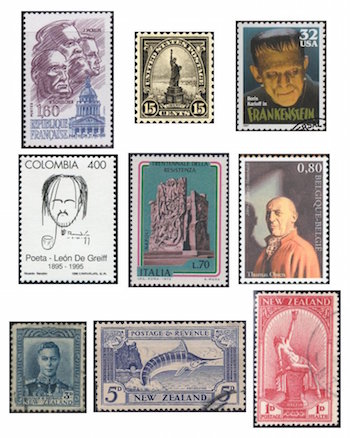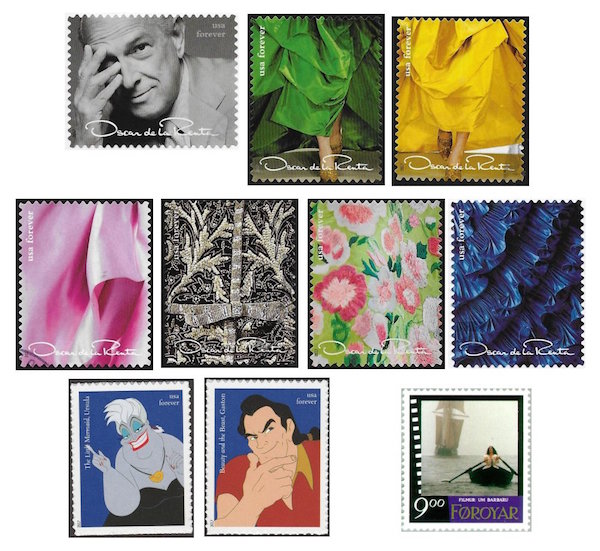The Arts on Stamps of the World — July 22
An Arts Fuse regular feature: the arts on stamps of the world.

By Doug Briscoe
The work of American realist painter Edward Hopper (July 22, 1882 – May 15, 1967) has enjoyed a great renascence in recent decades, especially since the Whitney Museum’s traveling 1980 retrospective. The first stamp to show his work predates that exhibit by ten years, so perhaps it’s not surprising that the artist’s name is nowhere mentioned, the subject of the stamp being the anniversary of Maine’s statehood. The picture chosen was The Lighthouse at Two Lights (1929). It was 1998 before Hooper was acknowledged on a U.S. stamp, and that was with his now famous, indeed iconic Nighthawks (1942). But this issue was part of a sheet of American paintings by various artists. Hopper finally got his own stamp, showing The Long Leg (1935), in 2011. Other countries have caught Hopper fever, too: from France comes Morning Sun (1952), from St. Kitts Girl at Sewing Machine (1921), and from the Ivory Coast Summer Interior (1909). Incidentally, I mentioned here the other day that President Obama had selected a work by Giorgio Morandi for his living quarters in the White House. In 2014 Mr. Obama added two pictures by Hopper to the Oval Office: Cobb’s Barns, South Truro and Burly Cobb’s House, South Truro, both dated to the early 1930s, when Hopper and his wife began spending their summers on Cape Cod, building a house in South Truro in 1934. 29 of Hopper’s works, including First Branch of the White River (1938), are now held in the Museum of Fine Arts, Boston.

American poet and fiction writer Stephen Vincent Benét (July 22, 1898 – March 13, 1943) came from a distinguished military family and attended two military schools before matriculating at Yale. He had his first book of poems published at age 17. Besides his book-length poem John Brown’s Body (1928), which earned Benét the 1929 Pulitzer Prize, he was the author of much other poetry, several novels and plays, and among his stories two that are particularly well known: “The Devil and Daniel Webster” (1936), which was turned into a folk opera by Douglas Moore three years later, and the post-apocalyptic story “By the Waters of Babylon”. A reading of John Brown’s Body by Tyrone Power, Judith Anderson, and Raymond Massey, staged on Broadway in 1953 under Charles Laughton’s direction, was recorded and has recently been inducted into the Library of Congress’s National Recording Registry.
A seventeenth-century woman painter from the Iberian peninsula is our next subject. Josefa de Óbidos, born in Spain around 1630, worked exclusively in Portugal, the country of her father, where she grew up from the age of four. She died on this date in 1684, and as early as 1696 she was being cited as one of the most important of Portuguese artists. Her birth name was Josefa de Ayala Figueira, her father was a painter, and her first signed and dated work was done in 1647. It was the beginning of a career of altarpieces, portraits, and still-lifes that amounts to about 150 pictures. Shown on the Portuguese sheet is her Nativity of Jesus (1669).
French neoclassical architect Jacques-Germain Soufflot (July 22, 1713 – August 29, 1780) is best known for creating Paris’s Pantheon, the final resting place for a number of French notables. The stamp shows three of them, abolitionist writer Victor Schœlcher, Resistance fighter Jean Moulin, and Socialist leader Jean Jaurès, but the Pantheon also houses the remains of Voltaire, Rousseau, Victor Hugo, Émile Zola, Louis Braille, Antoine de Saint-Exupéry, Marie and Pierre Curie, André Malraux, and Toussaint Louverture, among others. Soufflot was also active in Lyon, where he built the Hôtel-Dieu and the Hôtel Marigny, the latter for his patron, the young brother of Madame de Pompadour. In 1755, the year the Pantheon was begun, Marigny, who been appointed Director General of Royal Buildings, put Soufflot in charge of all the royal buildings in Paris.
“Give us your tired, your poor …” So wrote Emma Lazarus (July 22, 1849 – November 19, 1887) in her 1883 sonnet “The New Colossus”, added to the Statue of Liberty in 1903. There is no stamp for her, so I simply show one of the many for the statue. This one happens to be a 1931 reprint of a design originally issued in 1922. Lazarus came from a Sephardic-Ashkenazi family of German and Portuguese descent. Her Jewish heritage did not have a deep meaning for her until she read George Eliot’s Daniel Deronda and learned of the pogroms that followed the assassination of Tsar Alexander II in 1881. She anticipated Theodor Herzl by advocating for a Jewish homeland. She also wrote a volume of poetry called Songs of a Semite (1882). In addition to the poems, there are a novel and two five-act plays. She was a cousin of Associate Justice of the U.S. Supreme Court Benjamin Cardozo.
The English director who gave us the classic 1931 Frankenstein was James Whale (22 July 1889 – 29 May 1957), whose other best known films are The Old Dark House (1932), The Invisible Man (1933), Bride of Frankenstein (1935), and the 1936 Show Boat. During World War I, Whale was a prisoner of war and put on amateur theatrical productions in the camp, serving as actor, writer, and set-designer. After the war he sought work as a cartoonist before turning to a career on the stage. In 1928 he directed Laurence Olivier in R. C. Sherriff’s Journey’s End, also directing the film in Hollywood the following year. In the trivia department, Whale was hired by Howard Hughes to make a talkie version of Hughes’s silent film Hell’s Angels (1930). Remarkably for his time, Whale was openly gay, living with producer David Lewis from 1930 to 1952. In 1995, Christopher Bram wrote a novel called Father of Frankenstein, which was made into the film Gods and Monsters with Ian McKellen three years later. Whale has no stamp in his honor, so I temporize with one for the Monster he, Mary Shelley, Boris Karloff, make-up artist Jack Pierce, and Dr. Viktor Frankenstein brought to life.

The Colombian poet León de Greiff was born Francisco de Asís León Bogislao de Greiff Haeusler in Medellín on this day in 1895. The name de Greiff derives from his father’s Swedish ancestry; the León was a nod to Tolstoy. He was expelled from university for his leftist agitation and never completed his formal education. He was a founding member of the group called los Panidas (the followers of Pan) in 1915. De Greiff was sufficiently knowledgeable in music to be named Professor of Music History at Colombia’s National University Conservatory in 1946. He also worked as a prominent civil servant, at one point serving as Director of Cultural Promotion and Fine Arts. Persecuted for his socialist sympathies, he was even briefly arrested and, on his release, resigned his government posts, but was almost immediately employed as a tax auditor. Subsequent to that he was appointed to the Colombian legation in his ancestral homeland of Sweden. He died aged 80 on July 11, 1976.
Renato Marino Mazzacurati (22 July 1907 – 18 September 1969) was an Italian painter and sculptor whose works reflected and sometimes combined elements of Cubism, Expressionism, and Realism. The stamp is one from a group of three honoring the sacrifices of the Italian Resistance movement during World War II. Mazzacurati’s sculpture, Four days of Naples, specifically recalls the culmination of a period of escalating violence as Allied bombing of the city intensified and ground forces approached. From the 27th to the 30th of September, 1943, Italian civilians conducted a number of operations against the German occupiers, hastening their evacuation of the city.
The Belgian writer of supernatural fiction—some 300 short stories—Gérald Bertot (July 22, 1910 – March 2, 2002) used the pseudonynm Thomas Owen. In his early days he had worked as an art critic and writer of detective fiction, which was characterized, it is said, by a “ferocious humor.” In his fantastic tales, French language Wikipedia goes on to say, “we are plunged into a universe in perpetual collision with horror and the irrational.”
Irish-born William J. Cooch (22 July 1898 – 17 September 1950) was a New Zealand artist, architect, calligrapher, and stamp designer. Cooch worked as a government architect in Wellington and created several stamp designs of the 1930s, including the frame (only) for the George VI series of 1937-47, the lovely swordfish stamp from 1935, and the Hygeia Goddess of Health stamp of 1932. An example of his nonphilatelic work is the painting Houghton Bay, also from 1932.

Fashion designer Oscar de la Renta was honored earlier this year with a full sheet of ten stamps of his designs plus one of the man himself. I show six of these and the portrait stamp. Óscar Arístides Renta Fiallo came into a prominent family in the Dominican Republic counting poets, scholars, soldiers, businessmen, doctors, lawyers, architects, diplomats, and politicians among their number. Born on this day in 1932, de la Renta studied painting in Spain, where his sketches were noticed by the American ambassador’s wife, who asked him to design a gown for her daughter. The resulting dress appeared on the cover of Life magazine. De la Renta’s progress in the field took him from Spain to Paris to New York. A board member of the Metropolitan Opera, Carnegie Hall, and WNET, he held dual citizenship in the Dominican Republic and the United States and died on 20 October 2014.
We offer a quick salute to composer Alan Menken (born July 22, 1949), who, besides his work for the theater has written extensively for film, often for Disney Animation, and this gives me the opportunity—or the excuse—to display some brand new U.S. stamps just issued a few days ago. The sheet of eight designs is devoted to villains from Disney cartoons, and Menken wrote the musical scores for two of them, The Little Mermaid (villain: Ursula) and Beauty and the Beast (villain: Gaston).
Norwegian actress Anneke von der Lippe (born 22 July 1964) worked in theater in the great 19th-century repertoire (Ibsen, Chekhov, Wilde…) before turning to film in 1992, appearing in the lead role in Leidulv Risan’s The Warrior’s Heart and winning the Amanda award (Norway’s Oscar) for her performance. She is the first Norwegian actor to win an International Emmy Award, this being for a 2005 television program. One the stamp she is seen in a still from Nils Malmros’s period drama Barbara (1997).
A graduate of the University of Massachusetts with a B.A. in English, Doug Briscoe worked in Boston classical music radio, at WCRB, WGBH, and WBUR, for about 25 years, beginning in 1977. He has the curious distinction of having succeeded Robert J. Lurtsema twice, first as host of WGBH’s weekday morning classical music program in 1993, then as host of the weekend program when Robert J.’s health failed in 2000. Doug also wrote liner notes for several of the late Gunther Schuller’s GM Recordings releases as well as program notes for the Boston Classical Orchestra. For the past few years he’s been posting a Facebook “blog” of classical music on stamps of the world, which has now been expanded to encompass all the arts for The Arts Fuse.
